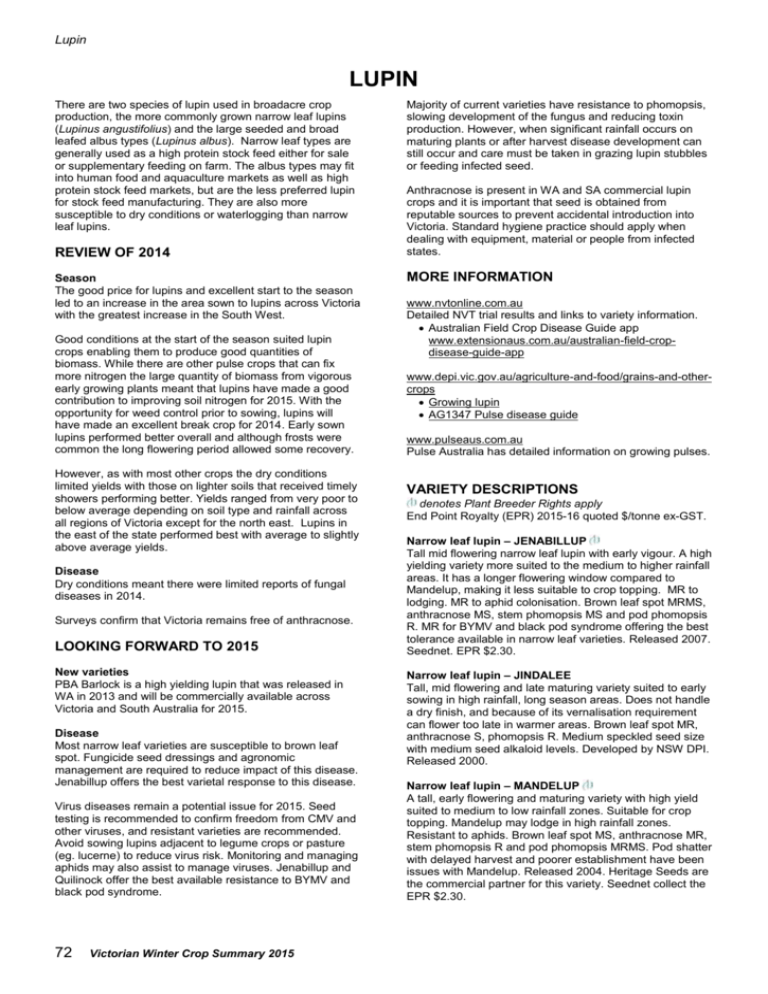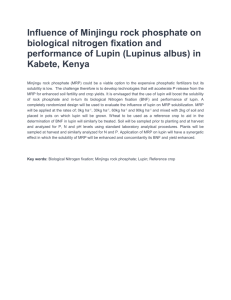Lupin - Agriculture
advertisement

Lupin LUPIN There are two species of lupin used in broadacre crop production, the more commonly grown narrow leaf lupins (Lupinus angustifolius) and the large seeded and broad leafed albus types (Lupinus albus). Narrow leaf types are generally used as a high protein stock feed either for sale or supplementary feeding on farm. The albus types may fit into human food and aquaculture markets as well as high protein stock feed markets, but are the less preferred lupin for stock feed manufacturing. They are also more susceptible to dry conditions or waterlogging than narrow leaf lupins. REVIEW OF 2014 Season The good price for lupins and excellent start to the season led to an increase in the area sown to lupins across Victoria with the greatest increase in the South West. Good conditions at the start of the season suited lupin crops enabling them to produce good quantities of biomass. While there are other pulse crops that can fix more nitrogen the large quantity of biomass from vigorous early growing plants meant that lupins have made a good contribution to improving soil nitrogen for 2015. With the opportunity for weed control prior to sowing, lupins will have made an excellent break crop for 2014. Early sown lupins performed better overall and although frosts were common the long flowering period allowed some recovery. However, as with most other crops the dry conditions limited yields with those on lighter soils that received timely showers performing better. Yields ranged from very poor to below average depending on soil type and rainfall across all regions of Victoria except for the north east. Lupins in the east of the state performed best with average to slightly above average yields. Disease Dry conditions meant there were limited reports of fungal diseases in 2014. Surveys confirm that Victoria remains free of anthracnose. LOOKING FORWARD TO 2015 New varieties PBA Barlock is a high yielding lupin that was released in WA in 2013 and will be commercially available across Victoria and South Australia for 2015. Disease Most narrow leaf varieties are susceptible to brown leaf spot. Fungicide seed dressings and agronomic management are required to reduce impact of this disease. Jenabillup offers the best varietal response to this disease. Virus diseases remain a potential issue for 2015. Seed testing is recommended to confirm freedom from CMV and other viruses, and resistant varieties are recommended. Avoid sowing lupins adjacent to legume crops or pasture (eg. lucerne) to reduce virus risk. Monitoring and managing aphids may also assist to manage viruses. Jenabillup and Quilinock offer the best available resistance to BYMV and black pod syndrome. 72 Victorian Winter Crop Summary 2015 Majority of current varieties have resistance to phomopsis, slowing development of the fungus and reducing toxin production. However, when significant rainfall occurs on maturing plants or after harvest disease development can still occur and care must be taken in grazing lupin stubbles or feeding infected seed. Anthracnose is present in WA and SA commercial lupin crops and it is important that seed is obtained from reputable sources to prevent accidental introduction into Victoria. Standard hygiene practice should apply when dealing with equipment, material or people from infected states. MORE INFORMATION www.nvtonline.com.au Detailed NVT trial results and links to variety information. Australian Field Crop Disease Guide app www.extensionaus.com.au/australian-field-cropdisease-guide-app www.depi.vic.gov.au/agriculture-and-food/grains-and-othercrops Growing lupin AG1347 Pulse disease guide www.pulseaus.com.au Pulse Australia has detailed information on growing pulses. VARIETY DESCRIPTIONS denotes Plant Breeder Rights apply End Point Royalty (EPR) 2015-16 quoted $/tonne ex-GST. Narrow leaf lupin – JENABILLUP Tall mid flowering narrow leaf lupin with early vigour. A high yielding variety more suited to the medium to higher rainfall areas. It has a longer flowering window compared to Mandelup, making it less suitable to crop topping. MR to lodging. MR to aphid colonisation. Brown leaf spot MRMS, anthracnose MS, stem phomopsis MS and pod phomopsis R. MR for BYMV and black pod syndrome offering the best tolerance available in narrow leaf varieties. Released 2007. Seednet. EPR $2.30. Narrow leaf lupin – JINDALEE Tall, mid flowering and late maturing variety suited to early sowing in high rainfall, long season areas. Does not handle a dry finish, and because of its vernalisation requirement can flower too late in warmer areas. Brown leaf spot MR, anthracnose S, phomopsis R. Medium speckled seed size with medium seed alkaloid levels. Developed by NSW DPI. Released 2000. Narrow leaf lupin – MANDELUP A tall, early flowering and maturing variety with high yield suited to medium to low rainfall zones. Suitable for crop topping. Mandelup may lodge in high rainfall zones. Resistant to aphids. Brown leaf spot MS, anthracnose MR, stem phomopsis R and pod phomopsis MRMS. Pod shatter with delayed harvest and poorer establishment have been issues with Mandelup. Released 2004. Heritage Seeds are the commercial partner for this variety. Seednet collect the EPR $2.30. Lupin Narrow leaf lupin – PBA BARLOCK Resistant to anthracnose, PBA Barlock is an early variety with slightly later flowering and maturing than Mandelup with a greater yield potential and more resistance to pod shatter. Resistant to aphids. Brown leaf spot MS, stem phomopsis MR and pod phomopsis R. Better metribuzin tolerance than Wonga. Released in WA in 2013 and eastern states in 2014 (WALAN2325). Seednet. EPR $2.50 Albus lupin – LUXOR A newer release to replace Kiev Mutant, but with resistance to Pleiochaeta root rot. Slightly taller than Kiev Mutant and suitable for lower to medium rainfall regions and high rainfall regions where Pleiochaeta root rot is a problem. Luxor is 100 per cent sweet and should not be grown within 2 km of other albus varieties to avoid bitter contamination. Released 2008. Seednet. EPR $2.80. Narrow leaf lupin – PBA GUNYIDI Released as a replacement of Mandelup, PBA Gunyidi is a slightly later flowering and maturing variety than Mandelup. PBA Gunyidi has proven widely adapted to a range of environments, and is considered an alternative to Mandelup, but with greater resistance to pod shattering. It is not as tall as Mandelup, and generally considered comparable to it for yield. Resistant to aphids. Brown leaf spot MS, anthracnose MR, stem and pod phomopsis R. It is only available in limited supply in eastern Australia and likely to be adopted only by those who are dissatisfied with Mandelup. Developed by PBA (WALAN2289). Released 2011. Seednet. EPR $2.50. Albus lupin – ROSETTA A release selected for improved yield and Pleiochaeta root rot resistance compared to Kiev Mutant. It is late flowering, making it suitable for medium and higher rainfall regions although has compared well with other albus varieties in the Mallee. It is tall and 100 per cent sweet, so should not be grown near other albus varieties. Very little is grown in the eastern states. Released 2007. Narrow leaf lupin – QUILINOCK High yielding narrow leaf lupin but SVS to anthracnose. It is early flowering for low to medium rainfall areas. Stem phomopsis MRMS and pod phomopsis MS. Released 1999. Limited quantities grown in eastern states due to anthracnose susceptibility. EPR $0.95. Narrow leaf lupin – WONGA Resistant to anthracnose with medium height and lodging resistance. Brown leaf spot MS, stem and pod phomopsis R. Best suited to medium rainfall districts, particularly when resistance to anthracnose is required. Released 1997. Albus lupin – KIEV MUTANT Once the most widely grown albus variety, but now superseded. It is of moderate height, grows vigorously, flowers early but matures late compared with narrow leaf lupins. Requires rainfall higher than 450mm to yield well. Does not handle waterlogged conditions. Alkaloid testing of seed is required. Bitter, large seeded albus lupin - LUPINI bean Varieties are Lago Azzurro, Mount Beauty and Murphy. They must be grown in complete isolation from sweet albus varieties due to the high alkaloid content of the seed and the potential to cross or contaminate sweet albus varieties. Production is for a niche market. Table 1: Optimal lupin sowing times for rainfall zones and soil types. Rainfall zone Average mm per year Below 350 mm 350 - 450 mm Above 450 mm Optimum sowing time Shallow sand over clay, sandy loams, loams mid April to early late April to early May May early to mid May mid May mid May late May Sands Table 2: Lupin variety agronomic and disease guide. Flower- Height Lodging Pod Drought ing shattering tolerance time Aphid resist Brown Pleiochaeta CMV Anthracroot rot seed nose leaf transmit spot Phomopsis Stem Pod Narrow leaf MR MS MS R Jenabillup M T MR MS MR MR MRMS R MS S R R Jindalee M-L M R MR MS MR R MS MR R MRMS Mandelup VE T MS MS MR R MS R RMR R MR R PBA E M MR R R MS Barlock MR MR R R PBA VE M MS R MR R MS R Gunyidi MR SVS MRMS MS Quilinock E S MS MR MR MS MRMS R R R R R Wonga E-M M MR R MS MR MS R Albus lupin Kiev Mutant E M R MS S MR VS R VS MR S Luxor E-M M-T R MS S MR R R VS MR S Rosetta M-L T R MS S MR MR R VS MR S Flowering time; VE=very early, E=early, M=mid, L=late Height; S=short, M=medium, T=tall Lodging and disease reactions; R = Resistant RMR = Resistant to moderately resistant MR = Moderately resistant MRMS = Moderately resistant to moderately susceptible MS = Moderately susceptible MSS = Moderately susceptible to susceptible S = Susceptible SVS = Susceptible to very susceptible VS = Very susceptible Victorian Winter Crop Summary 2015 73 Lupin Table 3: Lupin sowing guide. This table is a guide only and has been compiled from observations of the breeder and local departmental agronomists. MALLEE April May June July Narrow leaf Jenabillup, Mandelup, PBA Barlock, PBA > X X X X < < Gunyidi, Quilinock, Wonga Albus lupin Kiev Mutant, Luxor, Rosetta > X X X X < < WIMMERA April May June July Narrow leaf Jenabillup, Mandelup, PBA Barlock, PBA Gunyidi, Quilinock, Wonga Albus lupin Kiev Mutant, Luxor, Rosetta NORTH CENTRAL Narrow leaf Jenabillup, Jindalee, Mandelup, PBA Barlock, PBA Gunyidi, Quilinock, Wonga Albus lupin Kiev Mutant, Luxor, Rosetta NORTH EAST Narrow leaf Jenabillup, Jindalee, PBA Barlock, PBA Gunyidi, Quilinock, Wonga Albus lupin Kiev Mutant, Luxor, Rosetta SOUTH WEST > > X X X X < > > X X May X X < < June April < July > > X X X X < > > X X May X X < < June July June July April > X X X X < < > April X X X X May < < Narrow leaf Jenabillup, Jindalee, PBA Barlock, PBA > X X Gunyidi, Quilinock, Wonga Albus lupin Kiev Mutant, Luxor, Rosetta > X X >earlier than ideal, X optimum sowing time, < later than ideal but acceptable X X < < X X X < < Table 4: Long term predicted lupin yield 2007-2014 expressed as a percentage of the yield of Mandelup. The numbers in brackets indicate the number of site years in that area. Mandelup (t/ha) Coromup Jenabillup Jindalee Mandelup Moonah PBA Barlock PBA Gunyidi Quilinock Wonga 74 Victorian Winter Crop Summary 2015 Mallee 1.14 90 (10) 94 (13) 77 (4) 100 (13) 97 (4) 96 (9) 96 (13) 92 (7) 84 (12) North Central 1.97 93 (7) 96 (7) 100 (7) 95 (5) 99 (5) 83 (7) Lupin Table 5: Yield of lupin expressed as a percentage of the yield of Mandelup and 100 grain weight (g/100 seeds) in 2014 trials. Yield Mallee Hopetoun (F) Walpeup 30/4/14 2/5/14 1.44 0.77 77 65 88 87 92 88 100 100 95 91 89 74 94 92 85 74 Sowing Date Mandelup (t/ha) Coromup Danja Jenabillup Mandelup PBA Barlock PBA Gunyidi Quilinock Wonga Site Mean (t/ha) CV (%) LSD (%) F = Multiple frosts. 1.30 10 17 North Central Diggora 9/5/14 2.08 103 109 100 122 124 97 0.67 8 14 Grain weight Mallee Hopetoun 17.1 14.9 16.2 16.5 15.2 14.3 16.4 14.8 2.33 8 13 Table 6: Lupin disease guide. Disease Organism FUNGAL DISEASES Pleiochaeta Brown leaf setosa spot Symptoms Occurrence Inoculum source Control Dark spots on leaves and pods, often web like on leaves, infected leaves drop off, lesions may girdle stem. Very common but losses usually minor in dry areas, yield loss can be significant in cool damp areas. Serious reduction in lupin plant density and vigour. Spores survive in soil and lupin trash. Rain splash and wind blown rain spread the disease. Spores in soil infecting roots usually at seedling stage, spread also by rain splash. Early widespread infection severely reduces yield. Minor infections prevent use of harvested grain as seed. Brown necrotic streaks as Can be severe in plant dies back from growing higher rainfall areas, point of stem, shepherd usually transmitted crook of stem, pods from pasture. blackened and flat, leaves yellow, plants wilt and die. Seed borne infection in narrow leaf lupin, aphid vectored in crop. Pleiochaeta root rot Pleiochaeta setosa Browning and rotting of tap and lateral roots, seedling plant death. Rhizoctonia Rhizoctonia spp. Bare patches in crop, spear tipped root ends or hypocotyl rot and stain. Anthracnose Colletotrichum lupini VIRUS DISEASES CMV Cucumber mosaic virus BYMV Bean yellow mosaic virus Dark brown lesions containing pink/orange spore masses on stems, pods and occasionally leaves. Lesions cause bending and twisting of stems and pods and occur in crook of bend. Fungicide seed dressings, crop rotation, variety selection, early sowing, sow into cereal stubble. Minimum 4 year rotation between lupins, sowing 4-5 cm deep to avoid spore layer, fungicide seed dressings. Can be severe in Soil borne Tillage prior and during isolated patches, infection with wide sowing below seed reduces stand host range, depth, rotation has no density, favoured by survives as fungal effect. minimum tillage, wet fragments in soil soils and mild and plant debris. conditions. Severe infections Seed borne Clean seed and can result in infection. Spread machinery, resistant severing of stems or in crop by rain varieties, fungicide total pod abortion splash and wind. seed dressings. resulting in complete crop failure. Leaves are pale, bunched, and down curled with faint mosaic pattern. Aphid vectored, many hosts (including pasture legumes), seed borne in L. albus. Sow clean seed, use a seed test, high sowing rates and cereal barriers around crops reduce aphid transmission. High plant density, cereal barrier, control weed and volunteer lupins, avoid sowing adjacent to legume pastures. ACKNOWLEDGEMENTS Ivan Mock Mary Raynes Geoff Thomas Dodgshun Medlin Pulse Australia Department of Agriculture and Food, Perth Victorian Winter Crop Summary 2015 75






